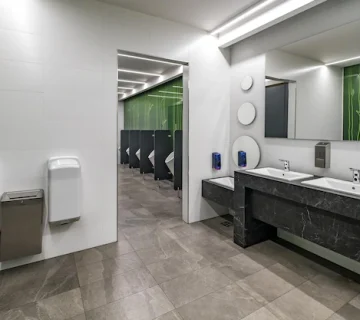Selecting the right toilet ceramics for your bathroom involves thoughtful consideration of various factors, and understanding the differences between porcelain and ceramic is a crucial starting point. In this guide, we delve into the specifics of porcelain and ceramic, exploring their characteristics, strengths, and potential drawbacks. Armed with this knowledge, you’ll be better equipped to make an informed decision that aligns with both your aesthetic preferences and practical requirements.
We begin by dissecting porcelain, highlighting its specific clay composition, exceptional strength, lower water absorption rate, and smoother appearance. While porcelain may come at a higher cost, its long-term durability and luxurious finish make it a popular choice for discerning homeowners.
Transitioning to ceramic, a broader category of clay-based products, we examine its composition, strength, water absorption rate, and finish. Ceramic is generally more budget-friendly than porcelain, offering a variety of design options at a slightly lower durability level.
The guide then seamlessly transitions into a comprehensive guide for choosing the right toilet ceramic. Factors such as size, flushing system, bowl shape, seat height, design, water efficiency, ease of cleaning, budget, and brand reputation are meticulously explored. Additional considerations such as installation requirements, warranty, accessibility features, environmental impact, technology integration, and matching accessories are also addressed.
To provide a convenient solution, we proudly introduce our collection as one of the best ceramic distributors. With a commitment to quality, diverse styles, expert guidance, and secure shopping, our collection aims to enhance your bathroom experience. Explore our wide variety of ceramic tiles, where quality meets style, and discover the perfect ceramic for your project.
Embark on this journey of understanding, exploration, and personalization to create a bathroom space that not only meets your functional needs but also reflects your unique style and preferences.

Types of Toilet Ceramics | Porcelain vs. Ceramic
When it comes to selecting the right toilet ceramics for your bathroom, understanding the differences between porcelain and ceramic is crucial. Each material comes with its own set of characteristics, pros, and cons. Let’s delve into the specifics of porcelain and ceramic to help you make an informed decision.
Porcelain
- Definition and Composition
– Porcelain is a type of ceramic that is distinguished by its specific clay composition. It is made from a combination of white clay, feldspar, and silica.
- Strength and Durability
– Porcelain is known for its exceptional strength and durability. It is fired at higher temperatures than regular ceramic, making it more resistant to wear, scratches, and chipping.
- Water Absorption
– Porcelain has a lower water absorption rate compared to ceramic. This characteristic makes porcelain an ideal choice for bathrooms, as it is less prone to water damage and staining.
- Finish and Appearance
– Porcelain often has a smoother and denser surface compared to ceramic. It can be manufactured to mimic various textures and patterns, providing a more refined and luxurious look.
- Cost
– Porcelain tends to be more expensive than ceramic due to the production process and the quality of materials used. However, many homeowners find the long-term durability and aesthetic appeal worth the investment.
Ceramic
- Definition and Composition
– Ceramic is a broader category that includes various types of clay-based products. It is made from a mixture of red, brown, or white clay, along with other natural materials.
- Strength and Durability
– While ceramic is durable, it is generally not as strong as porcelain. It is more prone to chipping and wear over time, especially in high-traffic areas.
- Water Absorption
– Ceramic has a higher water absorption rate compared to porcelain. This makes it more susceptible to water damage and staining, making it less suitable for areas with constant moisture exposure.
- Finish and Appearance
– Ceramic tiles often have a slightly rougher surface compared to porcelain. While this can add traction, it may also make cleaning a bit more challenging.
- Cost
– Ceramic is generally more budget-friendly than porcelain. It offers a cost-effective solution for homeowners who want a stylish and functional bathroom without breaking the bank.
Choosing the Right Type for You
When choosing between porcelain and ceramic for your toilet ceramics, consider factors such as your budget, desired aesthetic, and the level of maintenance you are willing to undertake. Porcelain is an excellent choice for those looking for a durable and elegant option, while ceramic provides a more budget-friendly alternative with a variety of design options. Ultimately, your decision should align with your preferences and the specific needs of your bathroom.

Choosing the Right Toilet Ceramic | Factors to Consider
Selecting the perfect toilet ceramic involves considering various factors to ensure it meets your functional and aesthetic preferences. Here’s a comprehensive guide to help you make an informed decision.
- Size and Dimension
– Consider the size of your bathroom and the available space for the toilet. Choose a toilet ceramic that fits comfortably without making the space feel cramped. Pay attention to both the height and width of the fixture.
- Flushing System
– Evaluate the flushing system of the toilet ceramic. Opt for a model with an efficient and water-saving flushing mechanism. Dual-flush systems are increasingly popular for their ability to conserve water based on the type of waste.
- Bowl Shape
– Toilet bowls come in various shapes, including round and elongated. The choice depends on personal comfort and the available space. Elongated bowls are known for providing additional comfort, while round bowls are suitable for smaller bathrooms.
- Seat Height
– Consider the height of the toilet seat, especially if the bathroom is used by individuals with varying mobility. Comfort height or ADA-compliant toilets are slightly taller, making them more accessible for users with mobility challenges.
- Design and Style
– Your toilet ceramic should complement the overall design of your bathroom. Choose a style that aligns with your aesthetic preferences, whether it’s modern, traditional, or somewhere in between. Pay attention to details like the shape of the tank and the design of the bowl.
- Water Efficiency
– Opt for a toilet ceramic that is water-efficient. Look for models with the WaterSense label, indicating that they meet specific criteria for water conservation. Water-efficient toilets not only help the environment but also contribute to lower water bills.
- Ease of Cleaning
– Consider the ease of cleaning and maintenance. Features such as a concealed trapway and a smooth, glazed surface make it easier to keep the toilet clean. Choose materials that resist stains and are easy to wipe down.
- Budget
– Establish a budget for your toilet ceramic. While there are premium options with advanced features, there are also budget-friendly choices that provide reliable performance. Determine the features that are non-negotiable and find a model that fits your financial plan.
- Installation Requirements
– Assess the installation requirements of the toilet ceramic. Some models may require professional installation, while others are designed for easy DIY installation. Factor in installation costs and feasibility based on your skill level.
- Brand Reputation
– Research the reputation of the brands you are considering. Look for customer reviews and ratings to gauge the reliability and performance of the toilet ceramics from different manufacturers.
- Warranty
– Check the warranty offered by the manufacturer. A solid warranty provides peace of mind and reflects the confidence the brand has in the durability of its product.
- Accessibility Features
– If your household includes individuals with specific mobility needs, consider toilets with accessibility features such as grab bars, raised seats, or those compliant with ADA standards.
- Environmental Impact
– Evaluate the environmental impact of the toilet ceramic. Some manufacturers prioritize sustainability and eco-friendly practices. Choosing a toilet ceramic with recycled materials or environmentally conscious production processes can align with your values.
- Technology Integration
– Explore toilet ceramics with integrated technologies, such as bidet functions, heated seats, or touchless flushing. While these features may add to the cost, they can enhance your overall bathroom experience.
- Matching Accessories
– Consider whether the toilet ceramic comes with matching accessories or if it can be easily coordinated with other bathroom fixtures and accessories. A cohesive bathroom design contributes to a harmonious overall aesthetic.
By carefully considering these factors, you can narrow down your options and find the perfect toilet ceramic that not only meets your practical needs but also enhances the overall look and feel of your bathroom space.




No comment